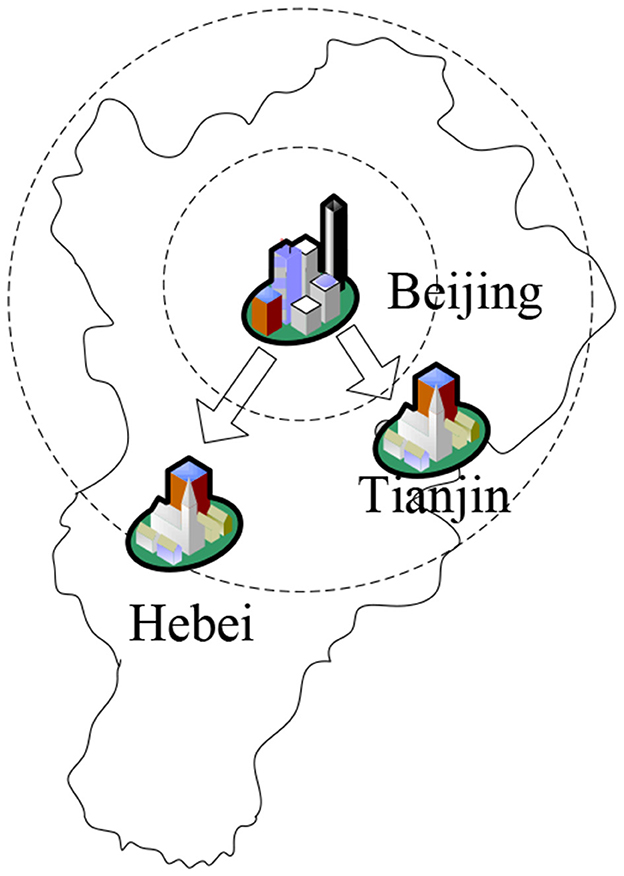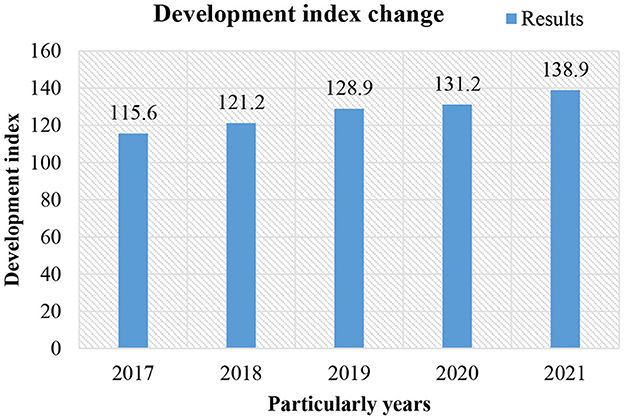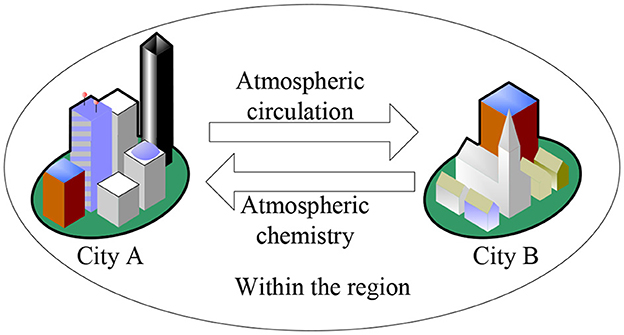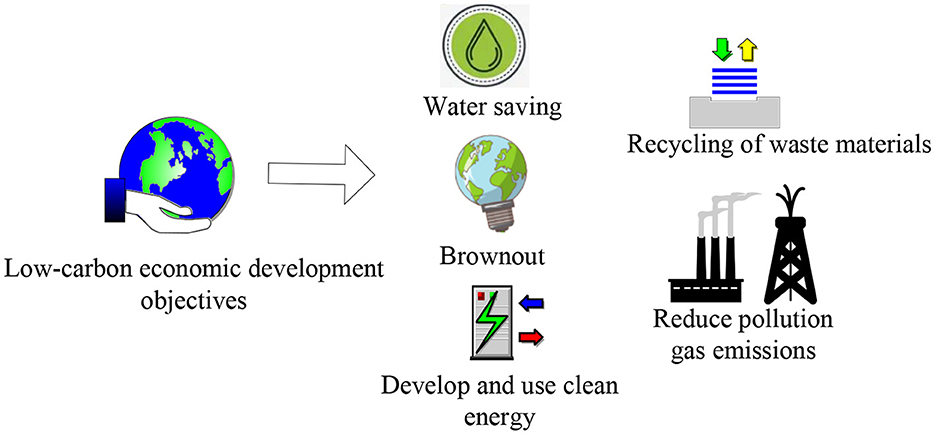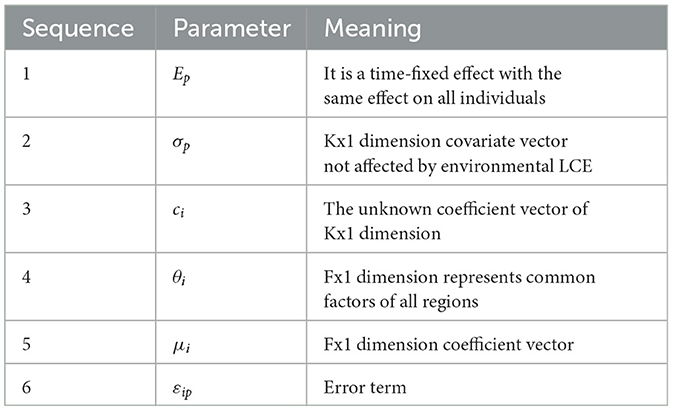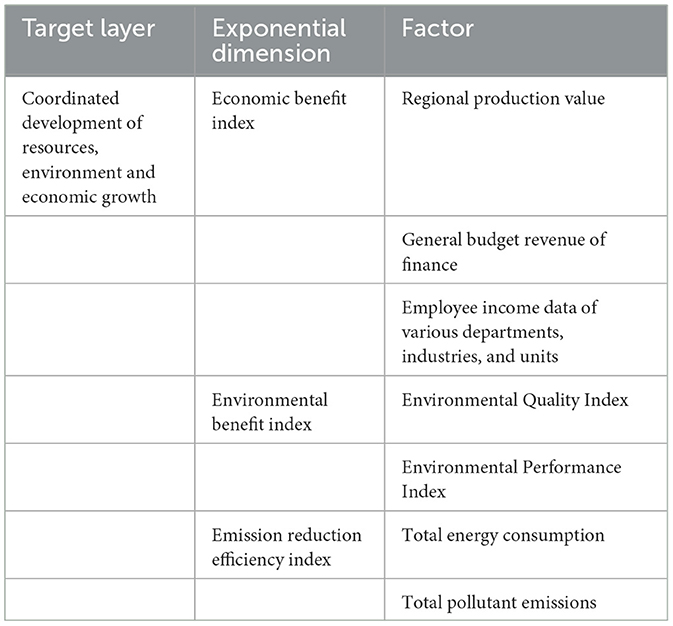- 1Eli Broad College of Business, Michigan State University, East Lansing, MI, United States
- 2D'Amore-McKim School of Business, Northeastern University, Boston, MA, United States
Introduction: At present, the rapid growth of social and economic development has also brought great challenges to the development of regional resources and environment. With the deepening of the concept of sustainable development, the coordinated development of regional resources, environment and economic growth has attracted more and more attention. The coordinated development of resources, environment and economic growth is not only the engine of industrial growth, but also the accelerator to promote industrial transfer and optimal allocation of resources, which has injected a strong impetus into social development. However, with the continuous upgrading of the industrial structure, environmental pollution, unbalanced economic development, resource shortage and other problems have gradually emerged in various important development areas.
Methods: In order to effectively solve this dilemma, this paper takes the Beijing-Tianjin-Hebei region (BTH) as an example, based on the analysis of the current situation of the economic and environmental development of BTH region and the influencing factors, combined with the background of low-carbon economy (LCE), effectively studies the coordinated development of its resources, environment and economic growth. In order to verify the effectiveness of low-carbon economic development, this paper, based on the actual development data of BTH region, tests the three dimensions of economic benefit index, environmental benefit index and emission reduction efficiency index.
Results: The results show that the average environmental benefit index of 13 cities in the BTH region after the implementation of the target is about 0.457. The average benefit index before the implementation of the target was about 0.449.
Discussion: From the final results of the test, it can be seen that the development of low-carbon economy has strong feasibility for promoting the coordinated development of regional resources, environment and economic growth.
1. Introduction
With the progress and development of the times, the process of industrialization and urbanization in various regions has also been accelerating. This has brought significant economic growth, but also brought many problems such as environmental pollution and ecological damage. In this context, it is difficult to coordinate the development of regional resources, environment and economic growth, which has a serious impact on the future healthy development of the region. In order to promote the coordination of resources, environment and economic growth, this paper takes the BTH region as an example. The BTH region has a large population, high economic strength and development potential, and unique geographical location, scientific and technological talents and resource advantages. It has an important strategic position in promoting the coordinated development of social economy. However, as an important economic hinterland around the Bohai Sea, the ecological problems in BTH region are also very prominent. This has had a serious impact on its future development. Therefore, promoting the coordinated development of BTH regional resources and environment and economic growth, and realizing the improvement and optimization of its ecological environment are the primary tasks of the current regional development. With the continuous popularization of sustainable development theory, the concept of LEC development has been put forward and has become one of the development concepts in many industrial fields, such as manufacturing industry, energy industry, chemical industry, and so on. Taking low carbon economy as the development goal, giving full play to the resource advantages of BTH region and realizing the comprehensive renovation of the development environment have important practical value for the coordinated development of BTH regional resources and environment and economic growth.
With the implementation of the ecological concept, the coordinated development of resources, environment and economic growth has become the focus of many scholars. Zhao Linlin has built a regional ecological synergy measurement model to scientifically evaluate the dynamic evolution of BTH regional ecological synergy level from 2006 to 2018. The results showed that improving the ecological synergy effect can create new growth impetus for the sustainable development of BTH regional economy (Zhao and Zhang, 2021). Sun Jing believed that the relationship between economic growth, urbanization and environmental quality has always been an important issue of sustainable development. In order to discuss the relationship between the three, he selected the panel data of 31 provinces in China from 2004 to 2015, and used the spatial Durbin model to conduct a spatial correlation test. He found that urbanization and economic growth would aggravate environmental pollution, but economic growth can alleviate environmental pollution in neighboring provinces (Sun et al., 2019). Khan Syed Abdul Rehman examined the potential relationship between environmental performance and sustainable economic growth in ASEAN countries. The structural formula model was used to test the hypothesis. The results showed that the use of renewable energy in logistics can not only improve the sustainability of the environment, but also create a better national image and provide better export opportunities in environmentally friendly countries to promote sustainable economic growth (Khan et al., 2020). Schroeder Patrick identified the relevance of Circular Economy (CE) practices to the achievement of Sustainable Development Goals (SDGs). Through literature review, he confirmed the matching results of the relationship between CE practice and SDG, and indicated that CE practice may directly contribute to the realization of a large number of sustainable development goals (Schroeder et al., 2019). At present, the research on economic growth and environmental optimization has been relatively mature, but with the complex changes in the social development environment, it still needs to be discussed from different objectives and perspectives.
LEC, as an important goal of the current regional development, plays an important guiding role in the green development of urban economy and environment. Khan Muhammad Kamran investigated the impact of natural resources, financial development and economic growth on the ecological footprint of Malaysia from 1980 to 2019 using the dynamic simulation autoregressive distribution lag method. Finally, based on the research results, a comprehensive policy framework was proposed to enable the Malaysian economy to achieve the SDG goal (Khan et al., 2021). Umar Muhammad used a multivariable system to investigate the relationship between China's environmental emissions and economic growth, globalization and other factors from 1980 to 2017. The results showed that economic growth and natural resources have a positive impact on environmental emissions, which is of great significance for achieving sustainable economic development (Umar et al., 2020). The practical significance of the development goal of LEC has been fully explored and proved. However, most of the current research focuses on its theoretical significance, in order to carry out in-depth research in combination with the actual situation of regional development.
In order to alleviate the problems of environmental pollution and low ecological benefits in BTH region, this paper has carried out an in-depth study on the coordinated development of regional resources and economic growth in combination with the LCE development goal, According to the analysis model in this paper, the economic benefit index, environmental benefit index and emission reduction efficiency index of the cities in the BTH region before and after implementing the LEC targets were compared. After the implementation of the target, from the perspective of economic and environmental development benefits, the benefit index of each city in BTH region has increased, and the economic and environmental development space of each city has been greatly improved. In addition, from the perspective of the benefit index of emission reduction, the total energy consumption and pollutant emissions of cities in the region have been effectively controlled. From the comparison of development data before and after the implementation of the objectives, it can be seen that the coordinated development of regional resources, environment and economic growth in the context of low-carbon economy in this paper is more ideal, and has a unique role and practical significance in promoting the healthy development of various regions.
2. Coordinated development of resources, environment, and economic growth in Beijing-Tianjin-Hebei region
2.1. Overview of Beijing-Tianjin-Hebei regional economy, resources and environment
2.1.1. Definition
The BTH region consists of Beijing, Tianjin and Hebei Province, as shown in Figure 1. Beijing is in a leading position in the process of development in all aspects (such as economy, culture, technology, etc.). It has a strong economic force, a relatively complete industrial system, and a large international aviation hub and a radiation hub for civil aviation. Its overall strength is very strong. As a modern industrial metropolis, Tianjin is not only an important economic center in the northern region, but also an important base for machinery industry, modern manufacturing industry, service industry and polymerization industry. At the same time, it is also one of the most developed regions in import and export trade. Hebei province, as a coastal province, surrounds Beijing and Tianjin, and its economic level also has a certain foundation. Relying on its own characteristics and advantages, it has built a barrier in Tangshan for agricultural product processing, raw materials and heavy mechanical equipment manufacturing, energy storage and transportation, and ecological protection, which has accelerated the construction of Tangshan's modern coastal metropolis.
Environment is defined relative to a system or core thing. In the system of human production and life, the external part related to human can be regarded as the human environment. Regional resources are environmental factors that can create economic value under specific conditions. They are mainly used to improve people's current development and future development welfare. Therefore, natural elements such as soil, water, and the natural space composed of these elements are collectively referred to as regional resources. In a broad sense, regional resources and environment include not only resources that can directly generate economic benefits, but also natural factors that can indirectly generate economic benefits.
The optimization of regional resources and environment refers to a comprehensive concept to improve and control the environment, realize the coordinated development of natural ecosystem and human production and life, and maintain the human production environment by means of internal hierarchical mechanism control and instruction of administrative organs, taxation, fines, and the consciousness of the masses and enterprises. The development of regional resources and environment involves a wide range of fields and has a high degree of complexity. It is based on the external impact of the environment and will not change due to the division of administrative regions. The coordinated development of regional resources environment and economic growth is based on human survival and development, and aims to promote the coordinated development of human and nature.
Economic growth means that the market's ability to supply diverse economic commodities to the masses has been greatly improved. The development of this capability depends on the continuous progress of advanced technology and the continuous adjustment of supporting systems and concepts. Sustainable economic growth must be based on sustainable ecological capacity, social justice and people's active participation in decision-making. Its purpose is to realize all kinds of reasonable needs of people, and achieve green economic growth and protection of resources and environment while promoting the overall development of individuals (Hickel and Kallis, 2020).
Under the development of sustainable concept, the relationship between resources and environment and economic growth is becoming closer and closer (Tomislav, 2018). Economic development has a promoting effect on resources and environment; Resources and environment can also change the mode of economic development to a certain extent, and improve human requirements for quality of life and environmental quality. On the whole, the coordinated development of the two has a beneficial impact on the realization of the goal of sustainable development (Bali Swain and Yang-Wallentin, 2020).
2.1.2. Development status
2.1.2.1. Economic development
The advantaged geographical advantages provide favorable conditions for the economic development of the three places in BTH region, and also facilitate the trade exchanges among the three places. The transportation facilities of the cities in BTH region have been gradually improved, providing perfect supporting services for their own development, and further promoting the coordinated development of the BTH regional economy. The completion of Xiong'an New Area has played an important role in promoting the economic development of BTH region. Generally, the economic development speed of a region can be measured by the development index of a region. As shown in Figure 2, the development index of the BTH region showed a steady upward trend from 2017 to 2021, and changed from rapid development to relatively slow development, which indicates that the BTH region is not only pursuing the speed of development, but also paying more attention to the quality of development. Although the development speed of BTH is relatively slow at present, with the maturity and deepening of BTH's synergy strategy, there is still much room for its economic development.
However, although the coordinated economic development strategy has promoted the sustainable growth of BTH's regional economy and accelerated its industrial upgrading, there are still large differences between the economic development of BTH, the Yangtze River Delta and the Pearl River Delta. Compared with the other two regions, the output efficiency of BTH region is still low. This is mainly because the industrial division of BTH region is not reasonable, and most of the production factors are concentrated in Beijing, forming an industrial cluster. However, the industrial clusters in Hebei province are mainly concentrated on inefficient resources in Beijing, resulting in vicious competition in BTH region. This not only makes the regional economy difficult to concentrate on development, but also restricts the sustainable economic growth of BTH region.
2.1.2.2. Environmental development
BTH region is one of the most prominent areas where the contradiction between ecological environment and economic development is prominent. Its ecological and environmental problems have aroused great attention in the whole region and even in the whole society. Although the BTH region has issued corresponding environmental protection policies in recent years, from the perspective of relevant data and actual environmental benefits, the environmental governance efficiency of the cities in the BTH region is still relatively low, especially in reducing industrial emissions.
2.1.3. Influencing factors
2.1.3.1. Unbalanced regional development
The economic development level of the three major regions in BTH is directly related to the effectiveness of regional environmental protection and governance. Hebei mainly develops heavy industry. Compared with Beijing and Tianjin, its economic development level is low. In addition, under the objective development needs of economy and environment, Hebei has restricted the sustainable growth and resource and environment development of BTH region to a certain extent. At present, the development outline has clearly proposed to promote the coordinated development of the BTH regional economy and build the capital economic circle, which also represents that the coordinated development of the BTH regional economy has entered a substantive stage. However, its economic sustainable development and regional resources and environment contradictions still exist, and the problems such as obvious economic differences and blocked factor flow have not been significantly improved.
2.1.3.2. Non-standard industrial transfer
While industrial transfer and industrial structure adjustment promote industrial clusters and industrial division in the region, there are also serious regional environmental pollution and the lack of long-term environmental protection mechanisms, which have a serious impact on environmental sustainability and multifaceted development (Colapinto et al., 2020). In the process of industrial transfer in BTH region, especially the development of tertiary industries such as high-tech industry and modern service industry in Hebei Province, has greatly promoted the adjustment and upgrading of industrial structure in Hebei Province. However, from another perspective, the transfer of heavy industry, manufacturing and other industries in Beijing and Tianjin has greatly aggravated the environmental pollution in Hebei province. The industrial transfer in some areas can improve the environmental quality of the relocation area, but at the same time, it would cause serious environmental pollution to the relocation area. In addition, the mobility and diffusion of air pollution, water pollution and other environmental pollution make the overall regional environment unable to fundamentally change the entire regional environment. From the perspective of short-term interests, BTH regional industrial transfer has promoted the development of Hebei province and promoted the coordinated development of the three regions. However, from the perspective of long-term interests, industrial enterprises with serious pollution have not played a palliative role in improving the environment. In addition, BTH did not take corresponding control measures to solve the pollution problem when transferring polluting enterprises. Although most enterprises have received some financial support in the process of transfer, and to some extent have reduced the local employment pressure, they have not formed a complete industrial chain under the goal of sustainable development. They also did not fully understand the challenges of sustainability and included the transfer of pollution into the scope of environmental protection (Leal Filho et al., 2019).
2.1.3.3. Excessive energy consumption
With the expansion of urban scale and the development of urban agglomeration, the cities in the region are increasingly closely connected. At the same time, due to the joint effects of atmospheric circulation and atmospheric chemical effects, the air pollution between cities has an impact on each other. Especially, the pollutant transfer effect between neighboring cities is the most significant, as shown in Figure 3. At present, the energy consumption in BTH region is mainly concentrated on fossil fuels, thus generating a large amount of greenhouse gases. The exhaust gas generated by fossil fuels is not only used for combustion, but also comes from its production, storage and transportation process. Carbon dioxide emitted from urban road transport will not only affect the productivity of local enterprises, but also have a serious impact on the coordinated development of regional resources, environment and economic growth (Ullah and Al-Turjman, 2023).
2.2. The development of low-carbon economy
Low-carbon economy is an important part of social and economic development. It is a form of economic development guided by the idea of sustainable development, through technological innovation, institutional innovation, industrial transformation, new energy development and other ways, to minimize the consumption of high carbon energy such as coal and oil, reduce greenhouse gas emissions, and achieve win-win economic development and ecological environment protection. The development objectives of low carbon economy mainly include water conservation, electricity conservation, development and use of clean energy, waste recycling, and reduction of pollutant gas emissions, as shown in Figure 4.
LCE has unique advantages in promoting the coordinated development of resources, environment and economic growth in the BTH region, mainly in reducing environmental costs, promoting technological innovation, and reducing input and expanding output.
2.2.1. Reducing environmental costs
In terms of the internal production process of enterprises in BTH region, the impact of LCE development goals on environmental costs runs through all links before, during and after production. In the pre-production stage, under the influence of the formulation and implementation of LCE development goals, enterprises would tend to adopt a cleaner way in terms of purchasing production equipment and site selection. On the surface, although this measure seems to increase the initial investment cost, for the overall development of enterprises, the greening of production equipment and current sites can bring greater economic benefits to enterprises. In the middle stage of production, the establishment of LCE development goals reduces the production indicators that have adverse effects on the environment, thus achieving the environmental cost control of enterprises and increasing the environmental benefits of enterprises (Ning et al., 2022). In order to meet the requirements of reducing emissions, enterprises would improve production efficiency and invest additional funds for pollution monitoring, pollution measurement and pollution reporting. This can not only reduce the harm to the environment. At the same time, it reduces the cost of environmental protection maintenance of enterprises, which is embodied in the reduction of the cost of pollution tax and pollution fee. In the post-production stage, the cost of repairing the environmental damage caused by the enterprise's production activities and the cost of recycling waste would also be reduced to a certain extent.
2.2.2. Promoting technological innovation
With the development of low-carbon economy, the government will set a series of supporting measures, such as green finance and green tax, to encourage enterprises to carry out emission reduction activities. The government's support and rewards will stimulate enterprises' green technological innovation motivation, and also improve the green innovation efficiency of enterprises (Xu et al., 2022). The realization of low carbon economy can improve the production technology requirements of BTH regional enterprises, make their existing production equipment and process level achieve greater improvement, and promote the sustainable development of enterprise economy. By means of independent innovation and technology introduction, enterprises can update and transform existing production technologies and processes, improve their production efficiency and reduce production costs.
2.2.3. Reducing input and expanding output
The direct target of LCE targets is the input and output factors. Low carbon refers to reducing energy consumption in the input factors, and then changing the investment structure (Tang et al., 2019). However, there is uncertainty in the change of investment structure. On the one hand, the cleanliness of investment structure can be improved by reducing the investment in mineral energy; on the other hand, while reducing energy consumption, enterprises would also increase alternative production factors to maintain high output, thus promoting the innovation of enterprise product structure. In terms of unexpected production, energy consumption and combustion are important sources of greenhouse gases and other pollution in the production process. Therefore, reducing energy consumption would undoubtedly increase unexpected production. LCE is aimed at unexpected production. Based on this, production activities can effectively control the emissions of greenhouse gases and pollutants.
In order to quantify the role of LCE in the coordinated development of BTH regional resources, environment and economic growth, this paper takes the BTH urban areas after the implementation of the LCE development goals as the demonstration group, and the urban areas before the implementation of the LCE goals as the comparison group, and finally compares the differences between the development level of the demonstration group and the comparison group before and after the implementation of the LCE goals.
It is assumed that there are x+1 urban areas, city 1 implements the LCE target in phase p0, and the other four areas are not affected by the LCE target. ryip represents the potential results of city iwhen it is interfered by the LCE targets in p-th phase, and rnip represents the potential results of city i when it is not affected by the LCE targets in p-th phase, thus obtaining the causal effect of the LCE targets:
The dummy variable vip is introduced, which indicates whether region i would implement the BTH low-carbon economy target in p-th phase. If it is implemented, then vip = 1. If it is not implemented, then vip = 0. Then the observation result rip of city i in the p-th period is:
If the 1 city is affected by the LCE target after the p0(1 ≤ p0 ≤ p) phase, and the other three cities are not affected by the LCE target in all periods, the impact effect of the LCE target is deduced as follows:
In the p > p0 phase, potential result ryip can be effectively quantified when being interfered by LCE targets, while potential result rnip can not be quantified without being interfered by LCE targets. In order to estimate the counterfactual results of individual city 1 after phase p0, the following model is used to describe rnip:
The definitions of the parameters of the formula are shown in Table 1.
When a new sample arrives, instead of combining it with historical data and relearning it, the new sample is used to modify the previous model based on the model learned from previous historical data to improve data fitting accuracy. In order to estimate, this paper analyzes the decision number model combined with it.
Assuming that in the sequence of low-carbon economic development, there are s samples arriving at a certain node of the decision tree in region i, then all the new samples will increase the entropy value of the classification attribute, and then the entropy change will increase to the maximum value Emax, while the entropy change of a candidate attribute will achieve the minimum value Emin, then the total difference inequality between the previously selected classification attribute and the information entropy of the candidate attribute will be caused by the newly added s samples:
Assume that the number of new samples s is smaller than the number of samples bj on the attribute value j value segment, that is, s ≤ bj. Then, by scaling Equation (5), it can obtain:
The difference in information entropy between class attributes and candidate attributes determines the number of new samples s, so there are:
If the number of newly added samples s ≤ smax, the original classification attribute will be treated as the classification attribute of the node. If s>smax, the original classification attribute will be replaced, and the candidate attribute will be treated as the classification attribute of the node to trim the decision tree.
Under the analysis model in this paper, the coordinated development effect of BTH regional resources, environment and economic growth before and after the implementation of LCE objectives can be more intuitively characterized. On this basis, the corresponding adjustment and planning of the development policies and development directions of the cities in the region can effectively promote the implementation of the concept of sustainable development in the economy of each city and achieve the improvement and optimization of the ecological environment.
3. Test of coordinated development of regional resources, environment, and economic growth
In order to verify the feasibility of coordinated development of resources, environment and economic growth in BTH region under the background of LCE, this paper tests the development data of 13 cities in BTH region in 2022 according to the analysis model. The economic benefit index, environmental benefit index and emission reduction efficiency index of each city before and after implementing the LCE development goals were compared (the economic benefit, environmental benefit and efficiency index of energy conservation and emission reduction before the implementation of the LCE development goals are simulated by the weighted average of the real development data of each city in 2017–2021).
In order to conduct a more objective and accurate analysis of the economic benefit index, environmental benefit index, and emission reduction efficiency index, this paper uses a decision tree analysis model to analyze the spatial development data of the BTH region from 2017 to 2021, and determines the selection of index factors based on social development trends and characteristics, as shown in Table 2.
3.1. Economic benefit index
The urban economic benefit refers to the proportion between the total investment and the total output of a city. It refers to the economic aggregate of all departments and industries in a city. The urban economic benefit index is an important indicator to measure the level of economic development of a city and its position and value in the whole social and economic structure. This paper measured and synthesized the GDP, general budget revenue and employee income data of all departments, industries and units of 13 cities in the BTH region. The comparison results of the economic benefit index differences between cities before and after the implementation of LCE targets are shown in Figure 5.
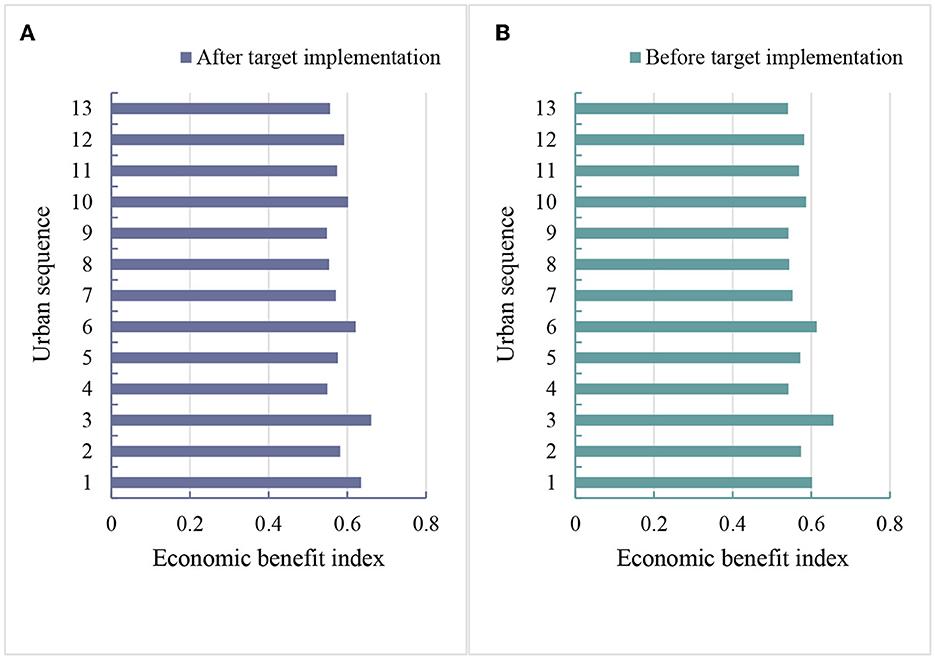
Figure 5. Change of economic benefit index. (A) Economic benefit index after target implementation. (B) Economic benefit index before target implementation.
From the overall index change results in Figure 5, the economic benefit index after the implementation of LCE targets has been significantly improved. In Figure 5A, the economic benefit indexes of the 13 cities in the BTH region after the implementation of the targets reached 0.635, 0.582, 0.661, 0.549, 0.576, 0.621, 0.571, 0.554, 0.548, 0.602, 0.574, 0.592, and 0.556 respectively, with the average benefit index reaching about 0.586. In Figure 5B, the economic benefit indexes of the 13 cities in the BTH region before the implementation of the targets were 0.602, 0.574, 0.656, 0.542, 0.572, 0.614, 0.553, 0.544, 0.542, 0.587, 0.569, 0.582, and 0.541, respectively, with an average benefit index of about 0.575. From the comparison of the specific results, it can be seen that after the implementation of the LCE targets, the economic development level of each city has improved. This is because urban enterprises have made technological innovation on their production equipment under the goal of LCE, reduced production consumption, and greatly saved costs, thus improving production efficiency and providing more opportunities and development space for the sustainable economic growth of their cities to a certain extent.
3.2. Environmental benefit index
Environmental benefits refer to tangible and intangible benefits of urban economic activities on natural ecology. Using the same natural resources can maintain the ecological balance, and avoid or improve the urban production and living environment. If the same natural resources are used, the environment and ecological balance would be damaged. The survival and production environment of the city would be deteriorated, and the environmental benefit index would be lower. This paper measured and synthesized the difference of the environmental status index of 13 urban areas in the BTH region. The comparison results of the differences in the environmental benefit indexes of cities before and after the implementation of the LCE targets are shown in Figure 6.
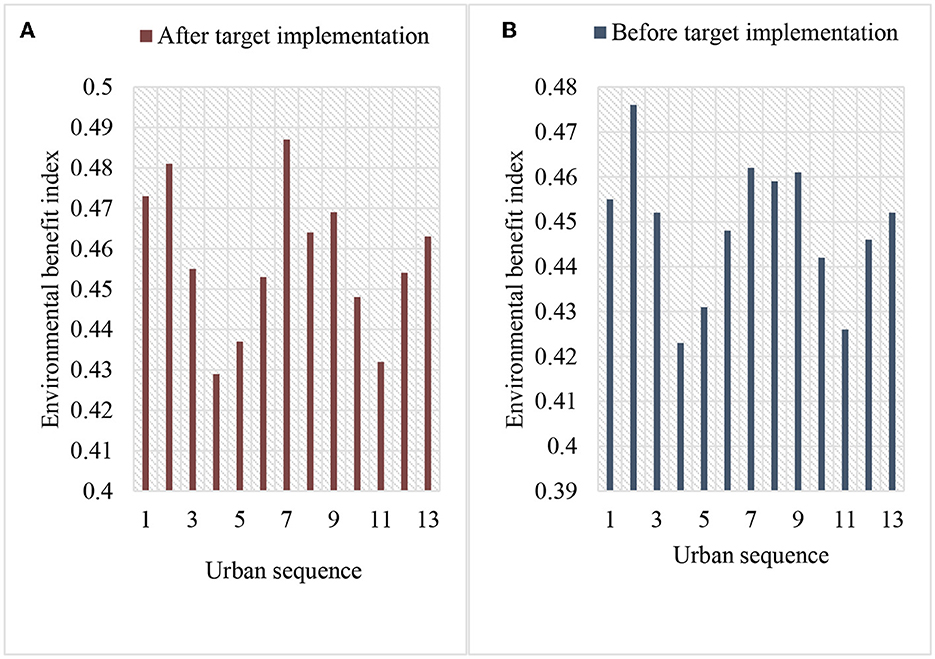
Figure 6. Change of environmental benefit index. (A) Environmental benefit index after target implementation. (B) Environmental benefit index before target implementation.
From Figure 6, the environmental benefit index before and after the implementation of the LCE target was generally low, which may be due to the highly specific heavy chemical industry in BTH region, but the index level after the implementation of the target has increased significantly. In Figure 6A, the environmental benefit indexes of the 13 cities in the BTH region after the implementation of the targets respectively reached 0.473, 0.481, 0.455, 0.429, 0.437, 0.453, 0.487, 0.464, 0.469, 0.448, 0.432, 0.454, and 0.463, with the average benefit index reaching about 0.457. In Figure 6B, the environmental benefit indexes of the 13 cities in the BTH region before implementation were 0.455, 0.476, 0.452, 0.423, 0.431, 0.448, 0.462, 0.459, 0.461, 0.442, 0.426, 0.446, and 0.452 respectively, with an average benefit index of about 0.449. From the change of index difference, the environmental benefits of cities have increased after implementing the LCE targets. Under the goal of LEC, the cost of energy consumption and environmental maintenance has generally decreased, and the urban environmental space has been well optimized, which ushers in more long-term and lasting direct and indirect benefits for urban development.
3.3. Emission reduction efficiency index
The emission reduction efficiency reflects the level of energy efficiency and ecological efficiency of a city. This paper calculated the difference between the current energy consumption and total pollutant emissions of 13 urban areas in the BTH region and the total energy consumption and total pollutant emissions of the previous year. The comparison results of the differences between the emission reduction efficiency indexes of each city before and after the implementation of the LCE targets are shown in Figure 7.
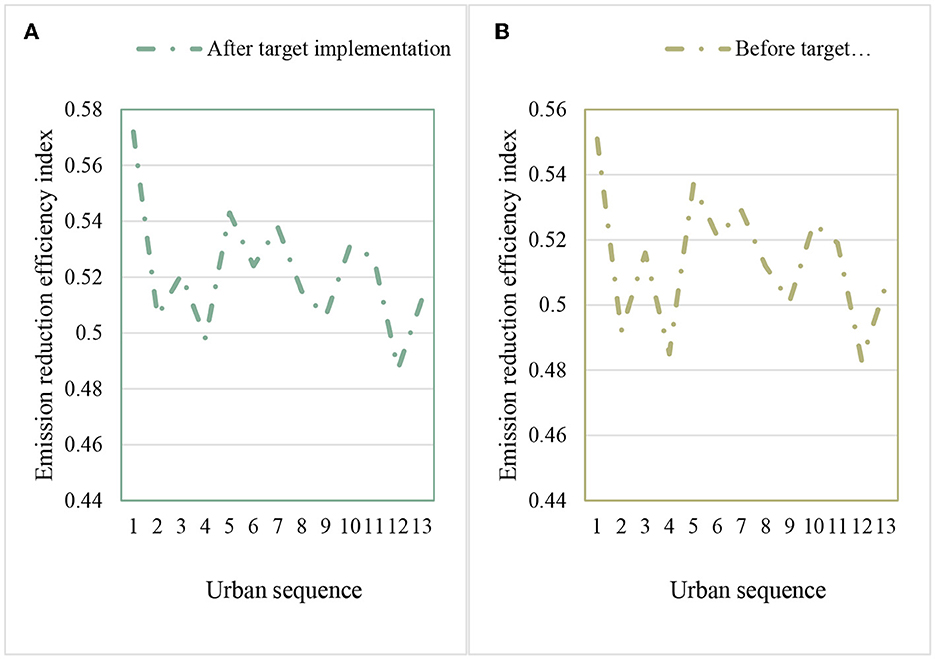
Figure 7. Change of emission reduction efficiency index. (A) Emission reduction efficiency index after target implementation. (B) Emission reduction efficiency index before target implementation.
In Figure 7A, the emission reduction efficiency index of the 13 cities in the BTH region after the implementation of the targets respectively reached 0.572, 0.506, 0.521, 0.498, 0.543, 0.524, 0.538, 0.515, 0.506, 0.531, 0.527, 0.487, and 0.512, and the average benefit index reached about 0.522. In Figure 7B, the emission reduction efficiency indexes of the 13 cities in the BTH region before the implementation of the targets were 0.551, 0.492, 0.516, 0.485, 0.537, 0.521, 0.529, 0.512, 0.501, 0.525, 0.519, 0.483, and 0.506 respectively, with the average benefit index of about 0.514. After the implementation of the target, the overall efficiency of energy utilization in each city has increased to a certain extent compared with that before the implementation of the target. The total amount of pollutant emissions caused by production activities has also decreased, and the effect and efficiency of emission reduction have been significantly improved.
4. Conclusions
The coordinated development of regional resources, environment and economic growth is of great significance to the healthy development of society. As an important production base in the industrial field of China and even the world, BTH has become an important strategic region leading the industrial development with its special geographical location, rich resource advantages and convenient transportation conditions, providing strong support for the rapid development of social economy. In order to realize the high-quality development of regional production, life and ecology, this paper, under the goal of LCE, has conducted in-depth research on the coordinated development of its regional resources, environment and economic growth. From the overall development of the region, after the implementation of the LCE goal, the economic development level and environmental benefits of the cities in the region have significantly increased, and their production consumption and pollutant emissions have also decreased to a certain extent. From the development differences before and after the implementation of the objectives, it can be seen that the LCE objectives have certain practical value for the coordinated development of BTH regional resources, environment and economic growth. However, due to the limitations of the research level and scope, there are still some areas worthy of improvement in this paper. In the follow-up research process, we will continue to improve the deficiencies in this paper to promote the better development of BTH region.
Data availability statement
The original contributions presented in the study are included in the article/supplementary material, further inquiries can be directed to the corresponding author.
Author contributions
ZW: conceptualization, methodology, software, validation, writing—original draft, writing—review, editing, and visualization.
Conflict of interest
The author declares that the research was conducted in the absence of any commercial or financial relationships that could be construed as a potential conflict of interest.
Publisher's note
All claims expressed in this article are solely those of the authors and do not necessarily represent those of their affiliated organizations, or those of the publisher, the editors and the reviewers. Any product that may be evaluated in this article, or claim that may be made by its manufacturer, is not guaranteed or endorsed by the publisher.
References
Bali Swain, R., and Yang-Wallentin, F. (2020). Achieving sustainable development goals: predicaments and strategies. Int. J. Sustain. Dev. World Ecol. 27, 96–106. doi: 10.1080/13504509.2019.1692316
Colapinto, C., Jayaraman, R., Ben Abdelaziz, F., and La Torre, D. (2020). Environmental sustainability and multifaceted development: multi-criteria decision models with applications. Ann. Operat. Res. 293, 405–432. doi: 10.1007/s10479-019-03403-y
Hickel, J., and Kallis, G. (2020). Is green growth possible? New Polit. Econ. 25, 469–486. doi: 10.1080/13563467.2019.1598964
Khan, M. K., Abbas, F., Godil, D. I., Sharif, A., Ahmed, Z., and Anser, M. K. (2021). Moving towards sustainability: how do natural resources, financial development, and economic growth interact with the ecological footprint in Malaysia? A dynamic ARDL approach. Environ. Sci. Pollut. Res. 28, 55579–55591. doi: 10.1007/s11356-021-14686-9
Khan, S. A. R., Zhang, Y., Kumar, A., Zavadskas, E., and Streimikiene, D. (2020). Measuring the impact of renewable energy, public health expenditure, logistics, and environmental performance on sustainable economic growth. Sustain. Dev. 28, 833–843. doi: 10.1002/sd.2034
Leal Filho, W., Tripathi, S. K., Andrade Guerra, J. B. S. O. D., Giné-Garriga, R., Orlovic Lovren, V., and Willats, J. (2019). Using the sustainable development goals towards a better understanding of sustainability challenges. Int. J. Sustain. Dev. World Ecol. 26, 179–190. doi: 10.1080/13504509.2018.1505674
Ning, X., Tian, W., He, F., Bai, X., Sun, L., and Li, W. (2022). Hyper-sausage coverage function neuron model and learning algorithm for image classi cation. Pattern Recogn. 136, 109216. doi: 10.1016/j.patcog.2022.109216
Schroeder, P., Anggraeni, K., and Weber, U. (2019). The relevance of circular economy practices to the sustainable development goals. J. Industrial Ecol. 23, 77–95. doi: 10.1111/jiec.12732
Sun, J., Wang, J., Wang, T., and Zhang, T. (2019). Urbanization, economic growth, and environmental pollution: partial differential analysis based on the spatial Durbin model. Manage. Environ. Qual. Int. J. 30, 483–494. doi: 10.1108/MEQ-05-2018-0101
Tang, L., Qu, J., Mi, Z., Bo, X., Chang, X., Anadon, L. D., et al. (2019). Substantial emission reductions from Chinese power plants after the introduction of ultra-low emissions standards. Nat. Energy 4, 929–938. doi: 10.1038/s41560-019-0468-1
Tomislav, K. (2018). The concept of sustainable development: From its beginning to the contemporary issues. Zagreb Int. Rev. Econ. Bus. 21, 67–94. doi: 10.2478/zireb-2018-0005
Ullah, F., and Al-Turjman, F. (2023). A conceptual framework for blockchain smart contract adoption to manage real estate deals in smart cities. Neural Comput. Applic. 35, 5033–5054. doi: 10.1007/s00521-021-05800-6
Umar, M., Ji, X., Kirikkaleli, D., Shahbaz, M., and Zhou, X. (2020). Environmental cost of natural resources utilization and economic growth: can China shift some burden through globalization for sustainable development? Sustain. Dev. 28, 1678–1688. doi: 10.1002/sd.2116
Xu, Y., Zhang, Y., Lu, Y., and Chen, J. (2022). The evolution rule of green innovation efficiency and its convergence of industrial enterprises in China. Environ. Sci. Pollut. Res. 29, 2894–2910. doi: 10.1007/s11356-021-15885-0
Keywords: regional resources and environment, economic growth, low-carbon economy, Beijing-Tianjin-Hebei region, coordinated development
Citation: Wang Z (2023) Coordinated development of regional resources, environment, and economic growth under the background of low-carbon economy. Front. Ecol. Evol. 11:1181990. doi: 10.3389/fevo.2023.1181990
Received: 08 March 2023; Accepted: 17 April 2023;
Published: 10 May 2023.
Edited by:
Xin Ning, Chinese Academy of Sciences (CAS), ChinaReviewed by:
Albert Chen, Saybrook University, United StatesRamani Selvanambi, VIT University, India
Shailesh Khapre, Indian Institute of Information Technology, Nagpur, India
Tao Yang, First Affiliated Hospital of Chongqing Medical University, China
Copyright © 2023 Wang. This is an open-access article distributed under the terms of the Creative Commons Attribution License (CC BY). The use, distribution or reproduction in other forums is permitted, provided the original author(s) and the copyright owner(s) are credited and that the original publication in this journal is cited, in accordance with accepted academic practice. No use, distribution or reproduction is permitted which does not comply with these terms.
*Correspondence: Ziwen Wang, dzY5MDg1NDI3NUAxMjYuY29t
 Ziwen Wang
Ziwen Wang